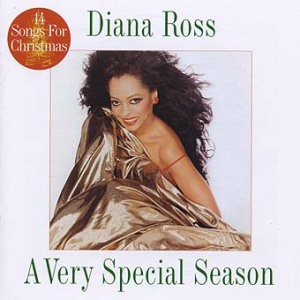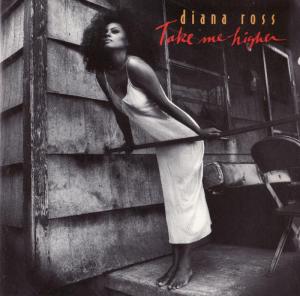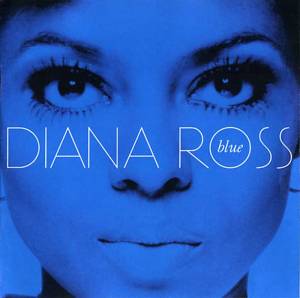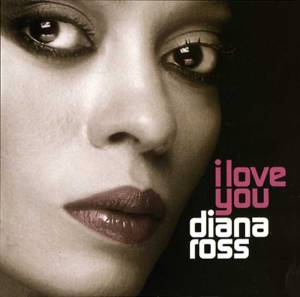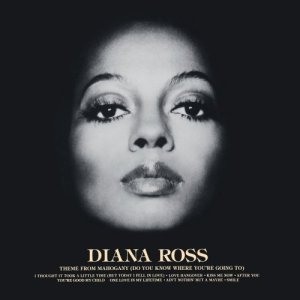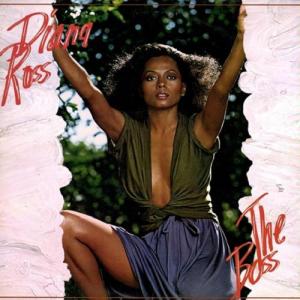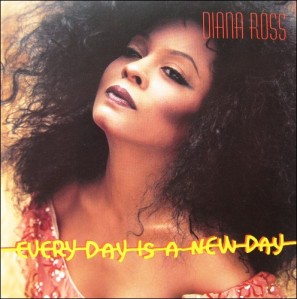
“I stand alone in the eye of the storm…”
Diana Ross rounded out her fourth decade in the music business with one of the busiest years she’d had in a long time; not only did she release her first studio album since 1995’s stellar Take Me Higher, but she also made a return to acting with the made-f0r-television film Double Platinum, which aired in May on ABC and co-starred young singer/actress Brandy. The movie — based around the music business — provided a unique opportunity for Miss Ross to promote her new album, and several of the songs from Every Day Is A New Day were also featured in the film. She promoted both projects with several notable television appearances, including “The Oprah Winfrey Show” (on which she performed both “He Lives In You” and “Love Is All That Matters”) and “The View,” and in the UK, with a taped special entitled “An Audience With Diana Ross.”
Like Take Me Higher, this album is a mix of adult soul/R&B tunes, inspirational ballads, and dance music. Production duties are as varied as they were on her previous two studio albums; the legendary Arif Mardin (who’d worked with Aretha Franklin, Chaka Khan, and Bette Midler) handles four of the 12 tracks here, and young singer-songwriter Malik Pendleton (known for work with Mary J. Blige, SWV, and Zhane) takes on another four of them. The song “Until We Meet Again” makes three appearances here; it’s first heard in ballad form, and then shows up again at the end of the CD in two remixes for the dancefloor (although only one remix is listed). One of these versions ended up at #2 on Billboard’s Dance Music/Club Play chart, once again giving Miss Ross a high-energy dance hit. In the UK, standout track “Not Over You Yet” was remixed and included; it was released as a single and became a top 10 hit there.
Miss Ross and the producers here had a lot to live up to with 1995’s Take Me Higher having been such a strong, cohesive album (although not a commercial success in the states), and this album doesn’t match the consistent quality of its predecessor. That said, Every Day Is A New Day is another sterling effort by Miss Ross, easily eclipsing 1989’s Workin’ Overtime and also edging past 1991’s The Force Behind The Power in terms of successfully keeping Diana Ross in line with modern trends while also respecting her legacy and place in the music business. Her voice is in good shape here; her performances on songs like “He Lives In You” and “Not Over You Yet” are among her best of the decade. That said, many have also noted a muted “sadness” to the album, often attributed to events going on in Miss Ross’s personal life at the time; she is quoted in J. Randy Taraborrelli’s Diana Ross: A Biography as saying, “I was almost in an emotional breakdown in my life when I did that album” (422). Whatever the case, there does seem to be a pensive, somber quality to much of the project and to some of her vocal performances, and while this makes the listening experience a little less energetic and joyful, it remains extremely compelling.
***
1. He Lives In You: Every Day Is A New Day wisely opens with one of its strongest inclusions; this is an epic song and performance that is one of the best Diana Ross album tracks in a long, long time. Featured in the 1998 Disney movie The Lion King II (and later included in the Broadway musical based on the original animated film), “He Lives In You” is an African-themed inspirational ballad boasting both English and Zulu lyrics, including the famous opening “Ingonyama nengw’ enamabala.” The version here is a vocal masterwork in every way; the choir of voices behind Miss Ross brings a sense of wonder and worldliness to the song with its strong, clear delivery of the African lyrics. Diana offers up a moving and distinguished performance, one of her most impressive on the album; her interpretation of the lyrics — delicate, yet powerful — is about as perfect as possible. Listen to her deliver the first chorus; she sings the lyrics “He lives in you…he lives in me…” with such a simplicity that it’s easy to overlook the way she manages to inject them with the authoritative wisdom needed to sell the almost-preachy message. Her cries of “Wait! There’s no mountain too great!” display her considerable skill at belting without needing to superfluously run up and down scales, and she easily plays the role of “choir leader” during the final minute or so, her own voice sliding in and out of the wash of melodic background voices. Much of the song’s credit also goes to the smart production by Mardin, featuring an absolutely killer violin solo by Karen Briggs that must be ranked among the best instrumental performances featured on a Diana Ross song ever. Given the immense popularity of the film and Broadway production of The Lion King, it’s a shame Diana’s version of this song isn’t better-known. It was featured in the movie Double Platinum, and she performed a breathtaking version of it for Oprah Winfrey during her 1999 appearance to promote the film, perhaps Diana’s single best television performance of the 90s; the applause following her performance was rapturous, proving what a crowd-pleaser the song is. Had it been released as a single, I’m not sure what market it would have been aimed at; still, the song is so good that it deserved a shot at a wider audience.
2. Love Is All That Matters: This is the Diane Warren-penned theme song to Diana’s television movie Double Platinum; it is the song that she performs with singer Brandy (playing her daughter) at the end of the movie, and the two singers promoted the song by performing it on Oprah (another stunning performance). The two women actually recorded a version of the song together, and it was planned as a single; unfortunately, a deal between labels was apparently never reached, and thus the song can only be heard in the movie (a shame; an early mention in Billboard Magazine predicted the duet would be a chart-topper). The version featured here is a Diana Ross solo performance; her voice is doubled, however, and she basically performs it as a duet with herself (as she did on 1982’s “In Your Arms”) — I’d venture the guess Brandy’s vocals were lifted out and Diana’s own “second” vocals plugged in. The song itself is classic Diane Warren, who was enjoying tremendous success in 1990s thanks to penning massive hits including Aerosmith’s “I Don’t Wanna Miss A Thing” and “How Do I Live” recorded by LeAnne Rimes. The lyrics and melody here are simple and memorable; the sing-songy verses and pretty chorus are certainly radio-friendly, and there’s a nice, powerful bridge typical of late-90s pop ballads. Miss Ross offers up a nice, if at times un-energetic performance; her delivery is crystal-clear, and her work on both the bridge and the final chorus of the song display a nice, raw power — her “Love is all that matters!” at 3:43 certainly shows off her ability to soar when she wants to. However, the verses are a bit slow-going; again, Diana’s voice is lovely, but she sounds a little sleepy on a few lines, and isn’t helped by the vaguely generic sound of the track. Typical of ballads from this era, the background is a wash of programmed instruments, rather than live playing; more distinction between actual instruments probably would’ve helped the song pop a little more. In any case, “Love Is All That Matters” is a memorable ballad, but it’s too bad listeners never got to hear it as a true duet, as intended.
3. Until We Meet Again: The album’s third song is an acoustic guitar-driven ballad also heavily featured in Double Platinum; this is the first of the really somber songs on the CD, and one of the most melancholy Ross performances since “Forever Young” from 1984’s Swept Away. Though the lilting guitar adds an exotic musical element to the song, the overwhelming feeling here is one of great sadness; Miss Ross’s voice sounds different here than it has on the previous two songs, almost “worn-out” in comparison to the uplifting “He Lives In You.” This is not to say that Diana sounds bad or weak here; she doesn’t. She does, however, sound like she’s emotionally drained; listen, for example to her utter “hey” at the end of the first verse (at :39 in), as though she’s given everything she’s got and is pushing through the song on sheer will. Interpreting music with such honesty is, of course, what makes Diana Ross such a truly great vocalist; few singers put the message and lyric of the song before themselves, and Diana Ross always has. However, in this case, the song can be a challenging repeat listen; it is so heavy that it almost becomes oppressive after awhile. Again, this is not a criticism of the singer or the song; “Until We Meet Again” is still an important inclusion on the album.
4. Got To Be Free: This song kicks off a quartet of contemporary soul tracks produced by ‘Zavy Kid’ Malik Pendleton; placing the four songs together at the center of the album (along with the similar “Sugarfree” produced by Chuckii Booker) turns this into an extended cool, slow-groove interlude, and the bouncy “Got To Be Free” is a nice way to start it all off and break the dense, dark atmosphere set by “Until We Meet Again” without being too jarring. The lyrics here inject a little power back into Miss Ross; while she crooned “…you’re always in my heart…” on the previous song, here she slickly declares, “You don’t know why, haven’t got a clue, in the dark about why I am leaving you.” Her performance here is laid-back and husky; there’s a deeper shading to her voice than was ever apparent on 1995’s Take Me Higher, and consequently she sounds even older and wiser than she did on that album. It seems like it took a long time for Diana Ross to really become comfortable using her lower register in the recording studio; she almost never did on her albums for RCA, nor on her early 90s works. Here, however, she is in full command of the lowest notes in her range, and she sounds fantastic; listen to her dive for the word “around” at 1:08. Producer Pendleton does a nice job creating a modern, hip track that still sounds appropriate for an artist of Ross’s stature and maturity; there’s a nice bass that’s playful but never overpowering, and the youthful background voices perfectly balance Miss Ross’s seasoned, smoky delivery. Though “Got To Be Free” isn’t the most memorable song here (it lacks a really strong hook), it’s a refreshing addition.
5. Not Over You Yet: This is one of the unqualified highlights of the album, not to mention Diana Ross’s solo output post-RCA. Brilliantly building off of “Got To Be Free,” writer/producer Malik Pendleton creates a hypnotic groove upon which Diana offers up one of her sexiest and more accomplished vocal performances. The track here has an industrial, metallic feel, as though the listener is hearing sounds lifted straight out of a factory; that muscular feel is an amazing counterpoint to Miss Ross’s smooth performance, in which she again demonstrates a mastery of her lower range. The control in her vocals here is really astounding; she skillfully glides along the melody, never letting the deepness of the notes or her hushed tones obscure the lyrics. The mesmeric, repetitive chorus is extremely well-constructed; it’s a strong, memorable hook that would have played very well on R&B radio, and Diana’s voice blends beautifully with the backing of Stephanie Cook and Mr. Pendleton himself. Diana’s work at 2:15, as the croons, “I love you so, I can’t let go, I’m crazy for you…” is genius; this is soul singing on par with anything released by any female singer in the late-90s, and is definitive proof for any of Miss Ross’s critics who say she’s not a “real” soul singer that indeed, she is and always has been. It is mind-boggling that Motown didn’t send this song immediately to R&B stations; it deserved a shot, and probably could have gotten strong play had it been give the right push. Once again, Diana’s overseas team showed much stronger judgement, choosing this song as a single and remixing it for clubs and radio; it was a top 10 hit in the UK, and should have enjoyed the same success for Diana at home.
6. So They Say: Another chunk of adult soul similar in sound to “Got To Be Free” and “Not Over You Yet,” this features an even “deeper” groove, and is a looser, more relaxed song in structure. This allows Miss Ross to give an appealingly sexy and confident vocal performance, with some nice, airy flourishes and a playfully light touch on the verses. The verses are relatively wordy (i.e. “Can’t say I regret that things that I got and didn’t get…”), but Miss Ross delivers them like a pro, vocally skipping along without ever tossing away words or jumbling them the way someone oversinging might have. This, of course, is one of the great skills of Diana Ross as a vocalist; her attention to the lyrics and the details in the words has always allowed her to sell a song. Her work here is similar in many ways to her performance on the #4 R&B hit “No Matter What You Do” — her duet with Al B. Sure! from the early 90s. Both songs have a leisurely, languid feel, allowing Miss Ross freedom to really dig into the material. While “No Matter What You Do” did well on R&B radio, “So They Say” is probably a little too loose to have been released as a single; there’s not much of a hook here and it’s not an immediately memorable composition in the way that “Not Over You Yet” or “He Lives In You” are. That said, it’s still a really nice performance and production, and a welcome addition here; Miss Ross was really hitting her stride with these smooth, soulful songs, and her command of the material is a joy.
7. Every Day Is A New Day: The album’s title track rounds out the quartet of Malik Pendlton productions, and is another album highlight; this is a rich, dynamic piece of neo-soul/jazz on par with the current and similarly-toned work being turned out by Jill Scott, Erykah Badu, and Angie Stone. This is another song that takes its time; the musical intro here is almost a minute long, before a progression of popping bass strings finally leads to the intricate tapestry of voices singing the song’s memorable chorus. Once again, Diana Ross is in relaxed voice, displaying some of the most confident vocals of her career; the song’s key perfectly suits both the deeper end of her range and her upper, breathy range, and it allows her to display both impressively. The lyrics here are a full 180 away from the morose “Until We Meet Again” — here, Diana sassily tells a former lover, “…now that you’re gone, I’m doin’ just fine without you…how I bless the day you went away.” As with the previous tune, co-writer Pendleton turns in some quickly-paced lines that force Diana to cram a lot of lyrics into a few bars of music, and once again she employs her lightness of touch to the material to keep it from sounding too dense. The shuffling beat here is nice, as is the popping bass, but most impressive is the vocal arrangement on the choruses, which combines Diana’s voice and that of the background singers into complex, jazzy chords. Together, the voices end up sounding almost like a grouping of brass instruments; the effect is interesting to listen to and adds a lot of depth to the song and the overall album. This is a striking addition to the Diana Ross discography, a song which takes advantage of her proficiency in both soul and jazz music; it’s enough of a standout that it certainly justifies being the title track of the CD.
8. Sugarfree: The contemporary soul continues with this track, written and produced by Chuckii Booker, who among other things has served as musical director for artists ranging from Janet Jackson to TLC to Faith Evans. This song certainly sounds like it could have been recorded by any of those artists, but it also manages to be a perfect fit for Miss Ross, who offers up another impressive performance. Though it was never released as a single, it interestingly gained some R&B airplay and stopped just outside the top 100 on that chart; had it gotten any promotion from Motown or Miss Ross, it probably could have charted much higher. While there are stronger compositions on the CD, this is a nice song with a catchy chorus and sly lyrics; it’s hard not to sing along with “…without my love, you’ll always be Sugarfree.” Miss Ross is full of feeling here; she even demonstrates a little melisma — something she’s not generally known for — such as at 2:28, at which she glides over several notes during the word “turned.” She also shows off a little more vocal strength than she had on the previous few songs, sounding clear and strong on her vocal run at 3:00. It’s too bad that once stations began picking up the song, the label didn’t jump on it; it likely wouldn’t have gotten any pop play, but it would have been a nice fit on R&B radio in 1999, a year when female artists were dominating (Deborah Cox, Whitney Houston, TLC, Destiny’s Child, Faith Evans, and Mariah Carey all enjoyed #1 R&B hits that year).
9. Someone That You Loved Before: After five mid-tempo soul stunners in a row, Diana Ross returns to the pop ballad here, recording another Diane Warren composition (which, like “Love Is All That Matters,” was also heavily featured in the TV movie Double Platinum). Of the three sweeping love ballads here (the other two being “Love Is All That Matters” and “Until We Meet Again”), this is the strongest in terms composition; it’s a deceptively simple melody and lyric which are instantly memorable and relatable. Had Diana Ross recorded this song in the mid-1970s, it probably would have been a #1 hit. Her vocal performance here is strong and effective, showier than on “Until We Meet Again” but similarly heavy; there are moments when Diana seems really, overwhelmingly sad. As with most Diane Warren ballads, there’s a big finish here, beginning around 2:22 as Diana howls, “Baby, I…” Her work for the duration of the song is beautifully rendered, with Diana finally getting to really push herself to the top limits of her range, something she hasn’t done much of until now. If there’s a fault here, it’s with the production; the sound of the track is a little generic and over-produced. It’s not bad, but there’s nothing really distinct about it and no single instrument really takes the lead, which results in a wash of programming behind Diana that really doesn’t match her emotion. Had the track been a little stronger, the song really could have been a standout ballad for Miss Ross; as it is, it’s a strong album track and a memorable vocal performance.
10. Hope Is An Open Window: A gospel-ish, soulful ballad that serves as this album’s “Only Love Can Conquer All” (from 1995’s Take Me Higher), this is a rare composition bearing the name Diana Ross as co-writer. Miss Ross apparently had the idea to incorporate Sonia Sanchez’s “An Anthem” into the song, which serves as a nice, modern intro; hearing another voice layered into the mix in such a unique way is a surprise and certainly different for a Diana Ross song. The uplifting song is built upon a slowly shuffling, almost locomotive instrumental line; it evokes images of a passing train, which fits perfectly with lyrics like, “I walk these city streets…see the people there…look into the eyes of quiet dispar.” Backing Diana along with the session singers (including, by the way, Alicia Moore, later known as pop artist Pink!), is the New Creation Choir, and the full, powerful voices are absolutely stunning. Miss Ross herself turns in a nicely pitched performance; her clear, concise delivery easily transmits the message of compassion and companionship, and she does some nice, quiet wordless vocalizing during the bridge. Just a few short years after the release of Every Day Is A New Day, the United States was dealing with the most devastating terrorist attack in its history, and this song — for me — took on a whole new meaning; the lyrics here seem to completely capture both the strange isolation and then sudden rush of togetherness that followed the September 11th attacks of 2001. A song like this — honest, simple, and completely unpretentious — has the ability to becoming an emotional release and even a healing power for listeners, and on that level, “Hope Is An Open Window” is a major success and important addition to Diana Ross’s discography.
11. Carry On: Of all the great songs on 1995’s Take Me Higher, Diana Ross’s remake of “I Will Survive” had the biggest impact, becoming an anthem for the singer herself and becoming her concert-closer. Thus, it’s no surprise she chose to remake another dance song for this album, and went a little “deeper” this time to find Martha Wash’s early 90s club hit “Carry On.” Ross’s version figured into Double Platinum during the “Grammy party” scene, though the version on this CD is a remix of what’s heard in the film. In any case, this is a perfect dance song for Diana Ross; she sounds strong and energetic, displaying probably her best vocals on the entire project aside from possibly her work on “He Lives In You.” This song was club-ready, and thus it is a total mystery as to why her team chose to release to remixed “Until We Meet Again” to clubs instead of this one. I have no doubt that had “Carry On” been sent to clubs and radio, it would have garnered plenty of spins, and probably would have hit #1 on Billboard’s Dance Music/Club Play chart. Listen to her near-screech on “I stand alone…” at 1:01, and then to her “I won’t stop, I will not…BE DENIED!” at 2:27 — this is Diana Ross at her best, belting her heart out in a way that she rarely does, but excels at when she chooses to. This song even stood a chance at pop radio; in the aftermath of Cher’s worldwide #1 smash “Believe,” radio certainly would have been less reluctant to play a new song by a more seasoned singer, and this is a catchy, engaging recording that deserved to find success. After displaying smooth, confident, and controlled vocals on many of this CD’s songs, it’s nice to hear Diana really let loose and prove that her vocal stamina really hadn’t diminished much over the years; this is Diana the Dance Diva at her most impressive.
12. Until We Meet Again (Hex Hector Remix): Though it’s only listed as one track, there are actually two dance mixes of “Until We Meet Again” here; the first runs roughly 3:50, and is then followed by :30 seconds of silence, before the second begins at 4:20 (thus the total track’s listed running time of 8:05). The strategy to re-imagine this song was a success, in the regard that “Until We Meet Again” his #2 on the dance charts, although it didn’t get play on any other format. The song structure and vocals (lead and background) are retained from the earlier ballad version, so both dance versions here are different only in terms of the backing tracks and tempo; both are pretty good dance remixes, with the first a little darker in tone, and the second featuring a repetitive four-note motif similar to that on Cher’s massive dance hit “Believe.” Both are successful in terms of keeping the integrity of the original recording in tact while also progressing it forward for a new audience; they are as listenable as the original and don’t diminish Diana’s vocal performance at all. That said, as noted before, Every Day Is A New Day already had a dance stunner in “Carry On,” so it’s really unclear why Miss Ross and her team decided to remix this ballad and push it; I still believe “Carry On” had the potential to be a far bigger dance success (and a success on other formats) than this.
Not Over You Yet (Metro Radio Edit): The album’s biggest hit anywhere was this song, a top 10 in the UK propelled by an energetic video featuring Miss Ross in a sexy black leather catsuit. The original version of “Not Over You Yet” is one of this CD’s best songs, and this is brilliantly-conceived makeover; it works as a remix far better than either of the versions of “Until We Meet Again” — again, begging the question why Motown decided to remix that song and focus on it. The simmering original version of “Not Over You Yet” had the potential to be an R&B hit for Miss Ross, had it been given a proper push, and releasing this remix in the states could have further helped the song’s chance at success. With a one-two punch of “Not Over You Yet” and “Carry On” in dance clubs and the original “Not Over…” sent to R&B radio and BET, the fate of Every Day Is A New Day could have been very different in Diana’s home country.
Drop The Mask: An interesting, funky number released on the Japanese edition of this CD; many fans have speculated that this song was directed at Michael Jackson, as it was co-written by Miss Ross and contains pointed lyrics such as: “I knew you then, I love you now…you can call me up when it gets you down. Behind the shades there’s someone real…behind your eyes, I wonder how you feel…” I have no idea if this is really meant as a message for her old friend, but it’s certainly an unusual, sparse song; there’s some nice, Prince-like guitar work and eerily-arranged background vocals, and Miss Ross’s performance is slick and sly, making good use of her deeper tones. Though this is a memorable song, it’s not strong enough that it seems sorely missing from other editions of Every Day Is A New Day; if Diana Ross had to leave a few songs off for other markets, this wasn’t a bad choice to pass over.
Free (I’m Gone): Another rare side featured on the Japanese edition of Every Day…, this is a better recording than “Drop The Mask” and probably should have figured onto the US and UK-editions of the albums somehow; it’s far more unique and compelling than some of the other tunes that ended up being included on all versions of the project. The track is beautifully done, with a funky, neo-soul vibe that mixes vintage elements with a modern percussive beat very similar to the one featured on the TLC-smash “Waterfalls”; Diana’s performance is breathy and relaxed and she again impressively handles the quickly-paced, syncopated verses. The chorus here (“I’m Free…like the wind…independent…once again…”) isn’t the most “hooky” on the album, which is probably why it was left off; still I’d say this song is every bit as strong as “Got To Be Free” and “So They Say” and even “Until We Meet Again” and the track is good enough that it might have even gotten a little R&B airplay had it been given a chance in the states.
***
In his book Diana Ross: A Biography, J. Randy Taraborrelli writes of this album, “No one seemed to be interested in doing a thing to promote this record — even Diana lost interest in it” (521). This seems accurate; the only real “promotion” for Every Day Is A New Day came through some of the songs being featured in Double Platinum; Diana’s talk show appearances and magazine interviews during this time really focused only on the movie. The album would continue to be overshadowed in the next few years to come, with publicity surrounding Diana’s airport security incident at Heathrow in England, her divorce, and then her Supremes-themed tour, Return To Love. Consequently, the songs from this CD have really been lost over the years, with the All Music Guide writing it off by saying, “Although the album sounds good, nothing on it truly catches hold the way even such latter-day hits as ‘Missing You,’ ‘Swept Away’ and ‘Muscles’ did.”
Thankfully, this really isn’t true; there are plenty of songs here that catch hold, with some of them standing out as real career highlights. Overall, this album doesn’t match the consistent high quality of Take Me Higher; every single song on that album was perfectly produced and sequenced. Here, the biggest issue is that there seems to be two albums crammed into one; Diana’s sophisticated soul quintet (tracks 4-8) could have been expanded into one album, while the remaining productions seem to be pitched for another one. The somber, muted quality is also an added layer that makes listening a bit of a challenge at times; those expecting joy from the singer of “The Boss” and “I’m Coming Out” will be surprised by her obvious anguish on “Until We Meet Again” and “Someone That You Loved Before.” Still, Every Day Is A New Day is a successful work and a project that holds up well, and is easily one of the better complete albums of her solo years.
Final Analysis: 4.5/5 (Diana Manages To “Carry On”)
 New topic
New topic Printable
Printable
 Report post to moderator
Report post to moderator